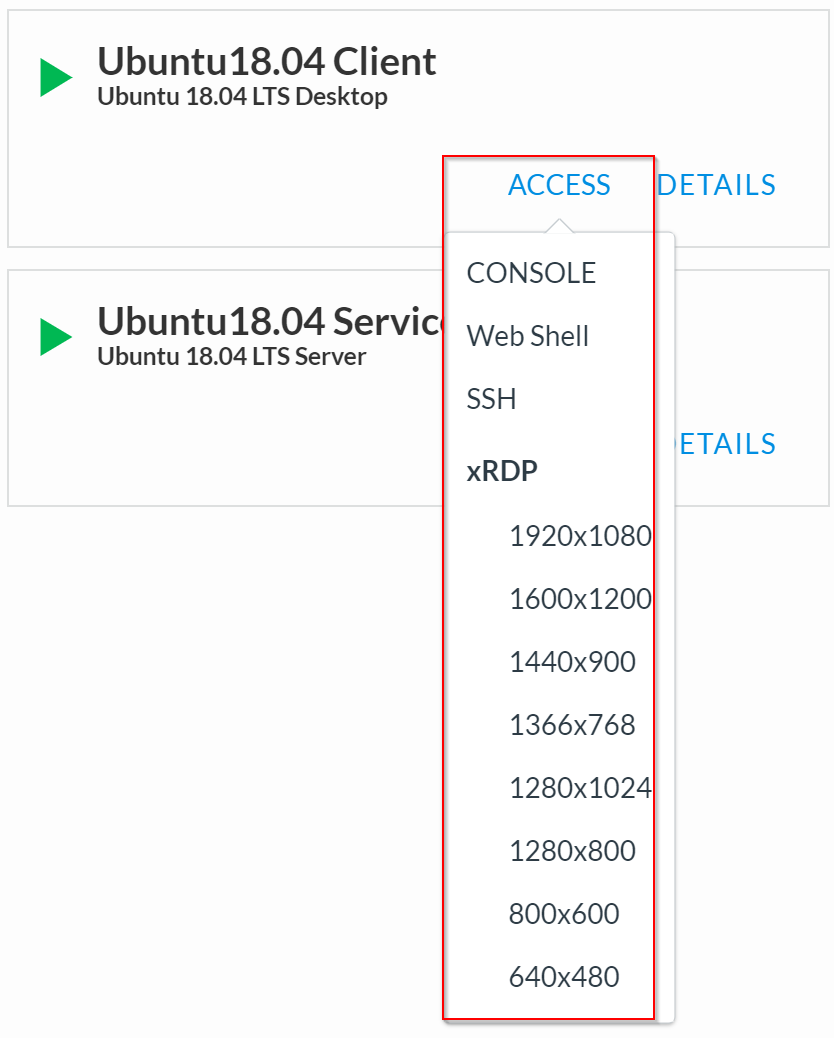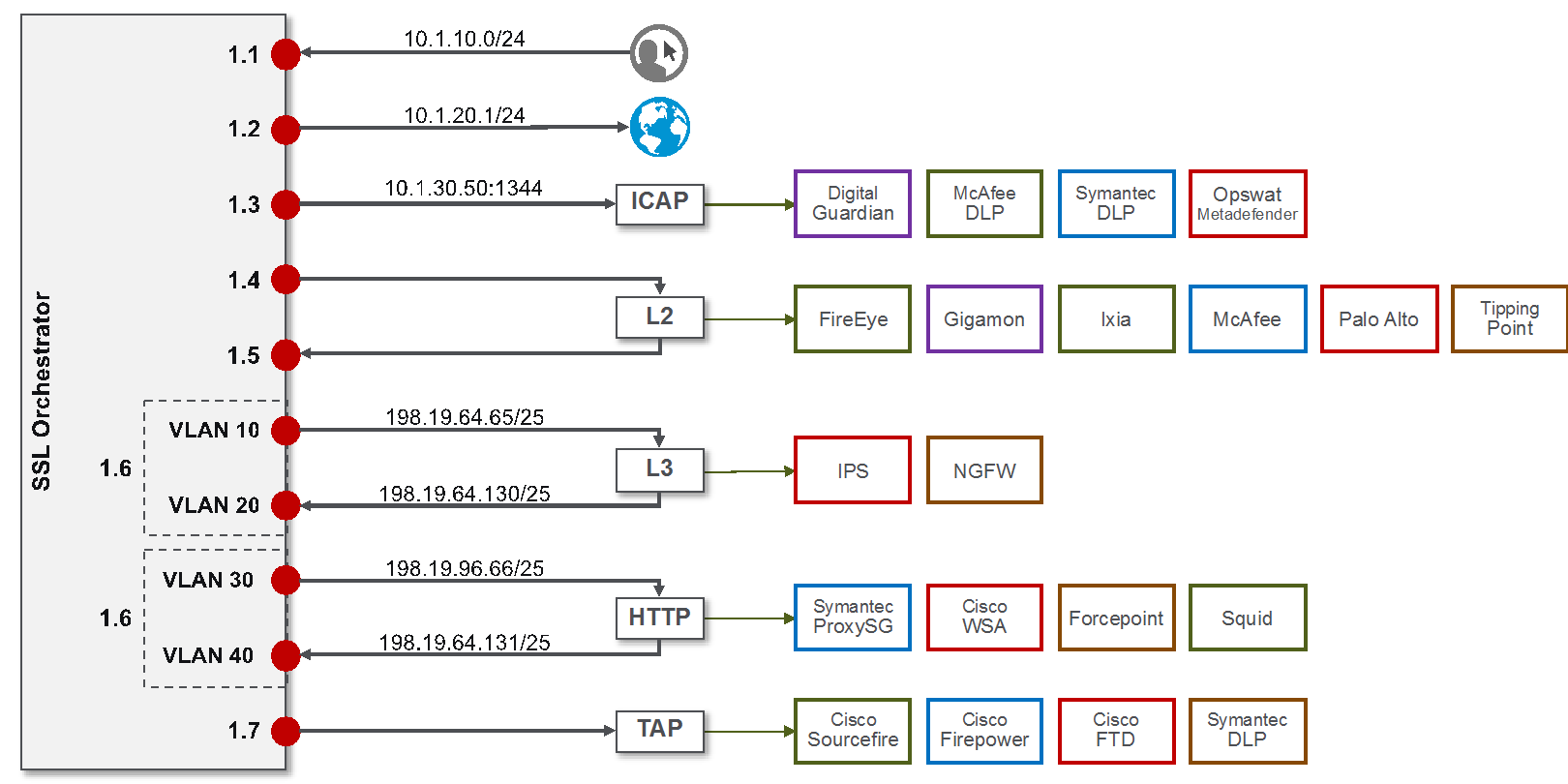F5 BIG-IP SSL Orchestrator Training Lab > All SSL Orchestrator Lab Guides > SSLO 101: Essential SSL Visibility with SSL Orchestrator (Agility 2022 | 2 hours) Source | Edit on
2. SSL Orchestrator Lab Environment¶
2.1. Accessing the Virtual Lab¶
If you are not familiar with the process for joining a training course, refer to:
To access your lab and lookup the necessary IP addresses, you should have received an email with your personal "Lab Portal Link". You will see the Lab Guide link and the VM's you'll spend all of your time attached to.
Note
All of your lab exercise work will be done from a single jump host (accessed via Remove Desktop Protocol (RDP) client).
You will not need to use SSH to access the UDF lab environment, so no SSH Key needs to be configured.
From the DEPLOYMENT tab, you will access the Ubuntu18.04 Client system over RDP. You can select the window resolution for the RDP session. An RDP file will be downloaded to your local system and you will need to open it to connect.

2.2. Lab Details¶
Most of this lab can be accomplished by directly attaching to the BIG-IP GUI.
Important
The lab environment for this guide has provided some prerequisite settings that you should be aware of. These are provided to make the lab simpler.
The following information is based on a custom UDF blue print named Agility 2022 - SSL Orchestrator 101.
Client side VLAN and subnet are pre-defined - this is the VLAN that an internal client connects to for outbound traffic flows. SSLO does not define the client-side VLAN(s) and self-IP(s).
Outbound side VLAN and subnet are pre-defined - this is the VLAN that traffic egresses from SSLO to the Internet gateway. SSLO does not define the server-side VLAN(s) and self-IP(s).
ICAP service VLAN and subnet are pre-defined - SSLO does not define the networking for this service type, so it has been pre-created in this lab.
CA certificate and private key are installed - this is the CA certificate and private key that are used to re-issue (forge) remote server certificates to internal clients for outbound traffic flows.
Server certificate and private key are installed - for the inbound (reverse proxy) traffic flow use case, SSL traffic is terminated at the F5, and re-encrypted on the way to the internal application environment. A wildcard server certificate is installed to facilitate using any name under the ".f5labs.com" sub-domain.
Tip
It is a security best practice to isolate security devices within the protected network enclaves provided by SSLO. Customers will often desire NOT to move or change existing security services. However, while possible with SSLO 4.0 and beyond, passing this decrypted traffic to points on an existing network architecture could create multiple points of data exposure. Usernames, passwords, credit card numbers and other sensitive information could be exposed to other devices on that network. Each inline layer 3 security service definition includes an "Auto Manage" option. This option, enabled by default, provides internal network settings for security services to use, so that only the interface (and 802.1q VLAN tag as needed) is required to be defined for the inbound and outbound interfaces. Should customers opt to not follow security best practices, or simply need different networking settings, you can disable the Auto Manage option and define all of the required inbound and outbound networking setting manually.
BIG-IP SSLO Management IP |
10.1.1.x (UDF-managed) |
|
Gateway IP/DNS |
10.1.20.1 |
|
Login |
admin:agility | root:default |
|
Interfaces |
Client VLAN |
1.1 |
Outbound VLAN |
1.2 |
|
Inline L3 service |
1.3 (tagged) |
|
Explicit Proxy (HTTP) service |
1.3 (tagged) |
|
ICAP service |
1.3 (tagged) |
|
Inline L2 service inbound |
1.4 |
|
Inline L2 service outbound |
1.5 |
|
Receive-only (TAP) service |
1.6 |
Login |
student:agility |
||
Interfaces |
Inbound interface |
1.3 tag 60 |
198.19.64.7/25 |
Outbound interface |
1.3 tag 70 |
198.19.64.245/25 |
Login |
root:default |
||
Interfaces |
Inbound interface |
1.3 tag 30 |
198.19.96.7/25 |
Outbound interface |
1.3 tag 40 |
198.19.96.245/25 |
|
Services |
Squid |
Port 31281 |
|
DansGuardian |
Port 8080 |
Login |
root:default |
|
Interface |
1.3 tag 50 |
198.19.97.50:1344 |
REQ/RES URLs |
/avscan |
Login |
student:agility |
Login |
root:default |
MAC Address |
12:12:12:12:12:12 (arbitrary if directly connected) |
Login |
root:default |
IP Addresses (*.f5labs.com) |
192.168.100.10 : 80 & 443 192.168.100.11 : 80 & 443 192.168.100.12 : 80 & 443 192.168.100.13 : 80 & 443 |
Login |
student:agility |
Inbound IP Address |
10.1.10.50 (RDP and SSH) |
Outbound IP Address |
10.1.20.50 (RDP and SSH) |
The following is a visual representation of this lab environment. The numbers inside the right edge of the SSL Orchestrator box indicate the port numbers assigned. The colored boxes to the right of the services indicate a few product examples for each respective service type.
